AOpen AK86-L UPDATE: Uncommonly Good
by Wesley Fink on March 30, 2004 1:00 PM EST- Posted in
- Motherboards
AOpen AK86-L: BIOS

The AK86-L uses the familiar Award BIOS. AOpen also includes a full set of tweak options, generally located under the Advanced Chipset Features and Frequency/Voltage Control tabs.

Recent AOpen BIOS has included a Credits tab where the people who developed the product are listed by name. It's a nice touch, and naming developers in the BIOS shows pride in the product.
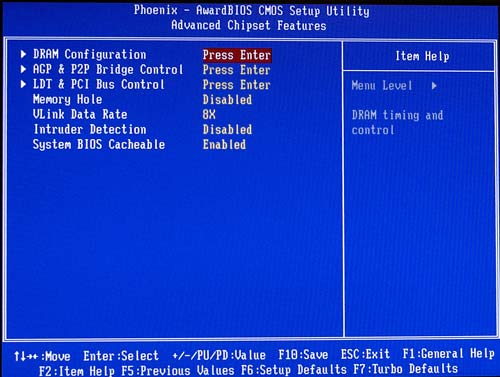
Advanced Chipset Features has submenus for DRAM and Hypertransport timings.
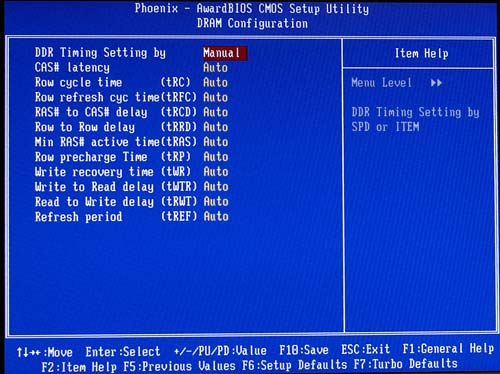
AOpen provides a very complete selection of memory timing adjustments in the DRAM submenu.
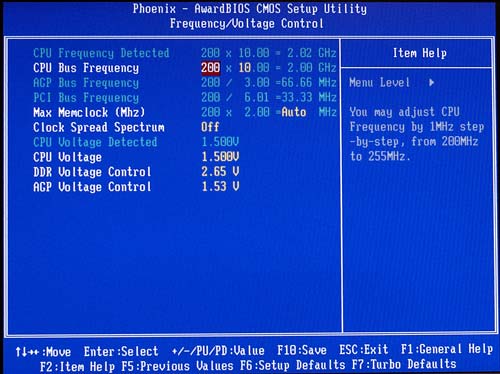
Frequency and Voltage adjustments are in this submenu. In addition, AOpen provides a readout on PCI and AGP frequencies. We were not surprised to see 33/66 at 200. Further testing with a PC Geiger showed that PCI/AGP was actually ratio-controlled, similar to what we have seen on Abit VIA K8T800 boards for Athlon 64.
Submenus in Frequency/Voltage Control allow a wide range of options.
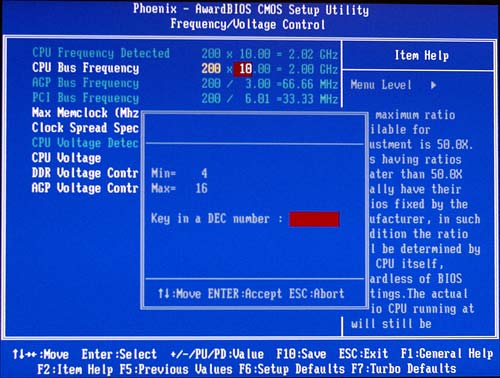
CPU multipliers below the rated speed can be selected in the BIOS. With a 3200+, the multiplier was 10, and we found values below 10 did work as selected. This capability means that the FSB adjustment to just 255 needs to be expanded by AOpen. We were able to reach 9x240 and 8x252 with our test 3200+ (10x200). With ratio adjustments, and ratio-driven PCI/AGP frequencies, you should be able to squeeze the most from high-speed memory with the AK86-L.

While CPU voltage can be adjusted from 0.8V to 1.55V, enthusiasts would prefer to see more voltage available on the top - to about 1.7V.

AOpen includes Memory Voltage adjustments from 2.5V to 2.7V in 0.05V increments. With some high-speed memory now warranting performance to 3.0V, this would be a better match to the other board capabilities with a wider range of memory voltage selections.
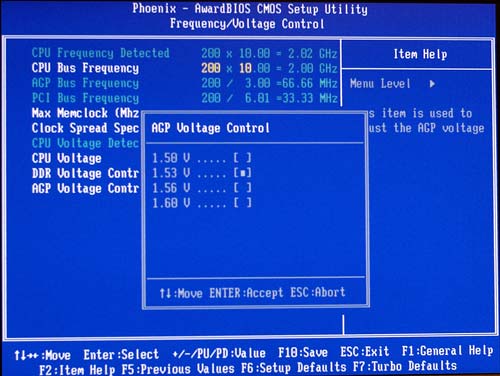
AGP voltage options are 1.5 to 1.6 in fine 0.033 increments.

The AK86-L includes smart fan controls in the Silent BIOS/HW Monitor section. You will also find a complete report of voltages. Beginning with the 1.06M BIOS, AOpen reports that they have added the AMD Athlon 64 Cool n Quiet feature.
The tweaking options in the AK86-L BIOS are outstanding for a production BIOS. There is very little to complain about in the options that are offered. However, the memory voltage and CPU voltage ranges need to be expanded to match the real capabilities of this board. A 200 to 255 CPU adjustment is OK, but a range to 300+ would be a better match to a BIOS providing CPU multiplier adjustments. AOpen has done a great job with the BIOS, but most Computer Enthusiasts would prefer to see wider adjustment ranges on this Athlon 64 motherboard.










22 Comments
View All Comments
howminn - Thursday, May 20, 2004 - link
I've got that board and am having hell with it. No matter what agp card, no matter what memory and in which memory slot, the board won't switch the monitor back on after restart. Which means it is not possible to install an OS onto it.I've returned the original board and bought another one, both boards have displayed the same trouble, and have both displayed cmos checksum error, default values loaded. Batteries have been changed, still no solution.
The vendor to whom I RMA'd the board have not given me any feedback as to what is wrong.
Has anybody else seen this before? Please!
cowdog - Sunday, April 4, 2004 - link
Good to see the update with information that AOpen "opened" up the bios options! Good job AOpen!Ditto what #14 said about the AK89 Max. Come on AOpen, don't overlook your nForce3 150 board!! DDR to 3.0v, cpu to 1.8v, fsb to 300Mhz. That would make my day, esp if AOpen also put that hyper-active watchdog on a shorter leash.
Ronnie - Wednesday, March 31, 2004 - link
Hey TrogdorJW, I also have the MSI K8T Neo and found that OCZ pc3200 works great for my setup, I tried some kingston hyperx pc-4000 with no luck.elixia - Wednesday, March 31, 2004 - link
Hey AMD4ME2, I had that problem on an old FIC motherboard. I simply pinned the power cable to the power supply and plugged it in. It will not hang in front of the CPU and block airflow this wayResh - Wednesday, March 31, 2004 - link
There was mention of a new board revision (as opposed to BIOS version). Could AT post the number codes for the new and old rev. to help us in purchasing?Thanks!
AMD4ME2 - Tuesday, March 30, 2004 - link
I'm a bit confused by the wording of the location of the ATX power connectors. they look to me like they are behind the processor blocking air flow, at least in my case they would be.Chuckles - Tuesday, March 30, 2004 - link
There is an error on page one (Index)."Adjustments for memory voltage have now been extended from 2.5V to 3.0v in 0.5v increments. This is an extremely wide and useful range for users trying to get the most from their memory."
Should be 0.05V instead of 0.5.
Pumpkinierre - Tuesday, March 30, 2004 - link
I posted my question on Feb.16(#12) and got my answer on March 30th (#13). Its never too late. Thanks for the follow-up.Venomous - Tuesday, March 30, 2004 - link
Westley, re: the AK89MAX.. Have them do the same kind of BIOS mods they did on the AK86. If they can bring those voltages up to AK86 specs, im sure hitting 280 fsb wont be hard. The watchdog thing IS annoying.Wesley Fink - Tuesday, March 30, 2004 - link
Pumkinierre -1.06Q was never a BIOS published by AOpen, so 1.08c is the first published BIOS that has multipliers. Ratios are the same as 1.06q, which is whole numbers - no option of 0.5 multipliers.
As I discussed in the PCI lock article and comments, the AK86-L seems to float the PCI/AGP up to 233, then at 234 it drops back to 33.3. This is a ratio arrangement very similar to what we saw in the Abit K8T800 motherboard we reviewed, and is much less flexible than a true adjustable PCI/AGP lock. If you look at the new screen captures you will see PCI/AGP now reports the rising frequency in the BIOS.
As mentioned in the update, the nForce3-150 based Gigabyte K8NNXP and the Shuttle AN50R, both nF3-150 based, are the only 2 Athlon 64 boards that I am aware of that are reported by respected writers to have AGP/PCI lock. I have not tested either with the PCI Geiger, so I can not personally confirm this. If you want fine adjustments for OC, then either of these would appear to be a better choice, at a higher price.
The AOpen AK89 Max, which is a very late nF3-150 board, also appears to have a working PCI/AGP lock, but there are some issues with high settings prematurely invoking the watchdog feature and resetting the frequency - requiring a CMOS clear. We have asked AOpen for help in resolving this issue with the AK89 Max, and if it is fixed we will post a review on Anandtech.